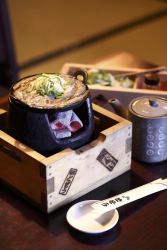
Originally published on metropolis.co.jp on April 2012


Sometimes you’ve just got to have a thick pork cutlet enrobed in a golden crust of crispy fried breadcrumbs. But locating tonkatsu perfection is not easy. The cutlet must be properly sized. The oil must be fresh and kept at exactly the proper scalding temperature. The breading must protect the flesh and seal in all the tender juices, yet come out entirely grease free.
Masaru Yamagawa learned the fine art from a master—his father, who started this modest little restaurant, almost fifty years ago. Over the decades, the father trained disciples who have gone on to set up their own Maru-named tonkatsu shops across Tokyo. Now, though, the son is the master and he serves some of the best cutlets in the city.
All the ingredients at Maru-ichi are carefully sourced. The pearly pink cutlets come from Iwate. The red-orange carrots are grown in Chiba, and the surprisingly sweet cabbages are harvested in the Miura peninsula where these leafy vegetables, especially those picked from late March to late April, are renowned.
It’s still a family operation at Maru-ichi. Masaru’s elderly mother, sporting a nifty white jacket and white kerchief, watches the rice, which is cooked in a large old-fashioned kama over a gas flame—the tastiest way to make rice.
Behind the counter at Masaru’s elbow, his wife readies each plate with a mound of lacy, shredded cabbage, a spring of curly parsley, and bright wedge of lemon.
Maru-ichi is a tiny place with only a seven-seat counter and two tables each seating four. The menu is small too. All orders are set menus, teishoku, with rice, house-made pickles, and tonjiru soup. You can choose either the leaner hire, (filet) or the luscious ros (loin) each at several weights: 170g, 250g, or—for the genuine trencherman—the 300g plate.
On my most recent visit, Masaru confided that he was fascinated by UFOs and Area 51 in Nevada. Maybe that explains the otherworldly flavors of the Maru-ichi teishoku. Compared to other tonkatsu joints, the rice is softer and more delicious; the carrots and cabbage sweeter; the meat more tender and flavorful. The real secret, though, is probably the great care that goes into everything at Maru-ichi. They go to the trouble, for example, of boiling the carrots, burdock, and onions separately to make sure they are evenly tender, before adding them to pork-based miso soup to make tonjiru.
Customers don’t mind the drab exterior of Maru-ichi. They know that the interior is spotlessly clean and all efforts at beauty are focused on the plate. On that recent visit, I ordered the 170-gram tonkatsu teishoku (¥1,300). Next to me, a well-dressed matron with a diamond-encrusted emerald ring as big as a walnut on her left hand ordered the mighty 250-gram teishoku (¥1,700). When she finished, she left without paying. She’s a joren, a regular, and she’ll get her bill at the of the month.





